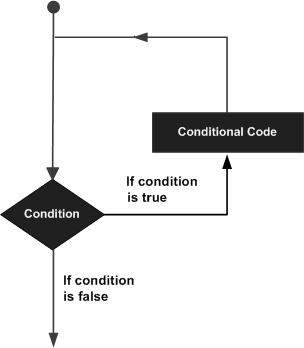- LISP 中的循环
- LISP-宏(1)
- LISP-树
- LISP 中的宏
- LISP 中的宏(1)
- LISP-树(1)
- LISP-宏
- LISP 中的循环结构
- LISP 中的循环结构(1)
- LISP 中的循环构造(1)
- LISP 中的循环构造
- LISP 中的函数
- LISP-字符串
- LISP 中的字符串
- LISP 中的字符串(1)
- LISP-字符串(1)
- LISP-文件I O(1)
- LISP-文件I / O
- LISP-设置(1)
- LISP-设置
- LISP-数字
- LISP-数字(1)
- LISP 中的列表(1)
- LISP-列表
- LISP 中的列表
- LISP-列表(1)
- LISP-字符(1)
- LISP-字符
- LISP 中的变量
📅 最后修改于: 2020-11-03 07:09:40 🧑 作者: Mango
在某些情况下,您需要执行一段代码次数。循环语句使我们可以多次执行一个语句或一组语句,以下是大多数编程语言中循环语句的一般形式。

LISP提供以下类型的构造来处理循环需求。单击以下链接以查看其详细信息。
| Sr.No. | Construct & Description |
|---|---|
| 1 | loop
The loop construct is the simplest form of iteration provided by LISP. In its simplest form, it allows you to execute some statement(s) repeatedly until it finds a return statement. |
| 2 | loop for
The loop for construct allows you to implement a for-loop like iteration as most common in other languages. |
| 3 | do
The do construct is also used for performing iteration using LISP. It provides a structured form of iteration. |
| 4 | dotimes
The dotimes construct allows looping for some fixed number of iterations. |
| 5 | dolist
The dolist construct allows iteration through each element of a list. |
优雅地退出街区
块和返回源可让您从任何嵌套块中正常退出,以防出现任何错误。
块函数使您可以创建包含零个或多个语句的主体的命名块。语法是-
(block block-name(
...
...
))
return-from函数采用一个块名和一个可选的(默认值为nil)返回值。
以下示例演示了这一点-
例
创建一个名为main.lisp的新源代码文件,并在其中键入以下代码-
(defun demo-function (flag)
(print 'entering-outer-block)
(block outer-block
(print 'entering-inner-block)
(print (block inner-block
(if flag
(return-from outer-block 3)
(return-from inner-block 5)
)
(print 'This-wil--not-be-printed))
)
(print 'left-inner-block)
(print 'leaving-outer-block)
t)
)
(demo-function t)
(terpri)
(demo-function nil)
当您单击执行按钮或键入Ctrl + E时,LISP立即执行它,返回的结果是-
ENTERING-OUTER-BLOCK
ENTERING-INNER-BLOCK
ENTERING-OUTER-BLOCK
ENTERING-INNER-BLOCK
5
LEFT-INNER-BLOCK
LEAVING-OUTER-BLOCK